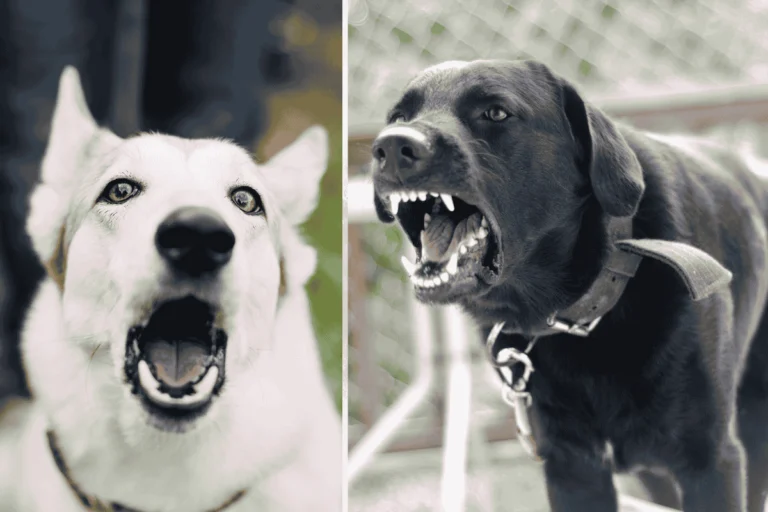Dog is Getting in my Face Barking? Here’s Why & What to Do
Ever found yourself in a situation where your dog barks right in your face? It can be overwhelming and leave you unsure of what to do. Dog barking is a common issue for many pet owners. But understanding why your dog barks can help you find ways to stop it.

So, why does your dog bark in your face? Let’s look at the main reasons and how to handle it.
Key Takeaways
- Dogs bark for various reasons, including alerting, social interaction, excitement, seeking attention, emotional distress, guarding, defending, frustration, and startling.
- Excessive barking can be a sign of underlying behavioral issues that need to be addressed.
- Understanding the root cause of your dog’s barking is crucial for finding the right solution.
- Positive reinforcement training and environmental management are effective strategies for reducing excessive barking.
- Please stay away from punishment-based methods since they can
Understanding Why Dogs Bark in Your Face
Figuring out why dogs bark at you can help solve the problem. They might bark for attention, to tell you something, or because they’re upset. Each reason is different and needs a different solution.
Attention-Seeking Behavior
Dogs bark at you to get your attention. This barking is usually short and has breaks in between. They want you to pet them, play with them, or give them food.
Communication of Needs
Your dog might bark to tell you they need something. This could be food, water, or playtime. They might bark a lot and also whine or pace around.
Emotional Distress Signals
Anxious or scared dogs bark at you as a way to show they’re upset. This happens when they’re left alone or in a small space. It means they’re feeling stressed or uncomfortable.
Knowing why your dog barks at you is critical to fixing the problem. By understanding the different reasons, you can find the best way to help them. This makes your dog happier and less likely to bark at you.
“Excessive barking can be a frustrating behavior, but with patience and the right approach, it can be effectively managed.”
Common Triggers for Face-Level Barking
If your dog is getting in your face and barking, there could be several reasons behind this behavior. Understanding the common triggers can help you address the issue effectively.
One of the primary triggers for face-level barking is unfamiliar sounds, such as doorbells, knocks, or other unexpected noises. This type of barking is often an alarm response, as your dog is trying to alert you to the perceived threat.
Excitement can also lead to face-level barking, especially during walks or when your dog sees other dogs. The heightened emotional state can cause them to engage in this attention-seeking behavior.
Boredom and frustration are also common triggers. Suppose your dog lacks sufficient mental and physical stimulation. In that case, they may resort to barking in your face as a way to get your attention and alleviate their boredom.
| Trigger | Explanation |
|---|---|
| Unfamiliar Sounds | Doorbells, knocks, or other unexpected noises can trigger an alarm response, leading to face-level barking. |
| Excitement | Seeing other dogs or going on walks can cause heightened emotional states, resulting in attention-seeking barking. |
| Boredom and Frustration | Insufficient mental and physical stimulation can lead to barking in your face as a way to get your attention. |
By understanding these common triggers, you can take proactive steps to prevent or manage the dog is getting in my face barking and address the underlying causes. This helps your dog feel more content and less inclined to why does this dog keep barking at me for attention.
When Your Dog is Getting in My Face Barking: Behavioral Analysis
Understanding why your dog barks at you is critical to fixing the issue. Let’s explore the various behaviors and what they mean.
Demand Barking Patterns
Dogs bark to get your attention or to tell you something. This barking is short and has breaks in between. It usually means they want something, like food or play.
Anxiety-Related Behaviors
Face-level barking can show your dog is anxious. This might happen when you leave or during walks. Finding out what causes their anxiety can help stop the barking.
Social Interaction Signals
When your dog barks excitedly at others, it’s a sign they want to play or say hello. They might also wag their tail and look relaxed. Knowing these signs helps you understand what they’re trying to say.
Leash reactivity, where dogs bark and pull towards others, is often mistaken for aggression. But it’s usually fear. Training and managing their environment can help.
Figuring out why your dog is barking can really strengthen your bond with them. Adjusting your approach based on their needs can make all the difference.
Health-Related Reasons Behind Excessive Barking
When your dog constantly barks, it’s vital to check for health problems. Hearing loss in older dogs can make them bark more. Pain from injuries or arthritis can also cause them to bark as they try to show they’re in pain.
Studies show over 60% of dogs bark too much because they want attention. They might want to go for walks or get petted. It’s vital to see a vet to rule out serious health issues. Focusing on training might not solve the problem.
Things like brain diseases or bee stings can make dogs bark a lot. Small dogs bark more in their sleep because they spend more time in the REM phase. Fixing these health issues is a crucial first step to stop your dog’s barking.

If your dog keeps barking after you’ve tried training, get help from a vet behaviorist. They can find medical problems and give the proper treatment. This way, your dog’s needs are met, and their barking is managed.
Positive Reinforcement Training Techniques
Positive reinforcement training is the best way to stop dogs from barking too much. It rewards calm and quiet behavior instead of punishing barking. Using treats and praise, you can teach your dog to be quiet and encourage good behavior.
Teaching the “Quiet” Command
Teaching the “quiet” command is a vital part of positive reinforcement training. Say “quiet” calmly when your dog starts barking. Please give them a treat or praise when they stop. Do this often, and your dog will learn that being quiet gets rewards.
Reward-Based Training Methods
There are other ways to stop dog barking with rewards. Give treats or praise when your dog is calm and not barking. This positive feedback will make your dog want to be quiet more often.
Consistency in Training
Being consistent is key in positive reinforcement training. Short, regular training sessions work better than long, rare ones. Stay patient and keep a routine, as it takes time for your dog to learn.
Positive reinforcement training is a kind and effective way to stop dog barking. By rewarding calm behavior and teaching new commands, you can help your dog communicate without barking too much.
Environmental Management Solutions
Dealing with a dog who barks a lot can be challenging. But, there are ways to manage their environment to reduce barking. By changing their surroundings and daily routine, you can make things calmer.
Limiting what your dog sees can help. Use privacy film on windows or place barriers to block views. Also, playing calming music or using a white noise machine can mask outside noises.
Make sure your dog’s basic needs are met. Give them enough exercise, mental play, and social time. Puzzle toys and regular play can prevent boredom barking. A consistent routine also helps reduce stress and anxiety.
“Modifying the environment and meeting your dog’s needs can go a long way in addressing barking issues. It’s about creating a calm, enriched space for your furry friend to thrive.”
Every dog is different, so what works for one might not work for another. It might take some time to find the right solutions. Be patient, consistent, and open to change to help your dog stop barking.

What Not to Do When Your Dog Barks at You
Dackling a barking dog can feel overwhelming. But it’s important to know that yelling or using water sprays won’t help. These methods can make your dog more anxious and even aggressive.
Avoiding Punishment
Dogs bark for many reasons, like needing attention or feeling upset. Punishing them can hurt your relationship. Instead, try to understand why they bark and use positive training to help.
Anti-Barking Devices
Using devices like shock collars is a bad idea. They can scare your dog and even make them aggressive. These tools don’t solve the problem and can harm your pet.
Common Training Mistakes
Don’t give in to attention-seeking barking by reacting right away. This can teach your dog that barking works. Also, don’t rush training. It can frustrate your dog and slow progress. Be patient and use positive methods to train.
Knowing what not to do can help you train your dog better. With the right approach and patience, you can help your dog sto
Creating a Daily Routine to Prevent Excessive Barking
Creating a daily routine is critical to managing your dog’s barking. It helps tackle issues like boredom, anxiety, and seeking attention. Start by making sure your dog gets enough exercise and playtime to avoid boredom barking.
Set regular feeding times and keep water fresh always. Mental games and puzzle toys can keep your dog busy and quiet. Always reward your dog for being calm and quiet to encourage good behavior.
With a routine that meets your dog’s needs, you can tackle excessive barking. This leads to a more peaceful home. With patience and uniformity, you can build a peaceful atmosphere that everyone in your family will enjoy.
FAQ
Why does my dog bark in my face?
Dogs bark for many reasons. They might want attention, need something, or feel upset. Knowing why they bark is critical to fixing the problem.
What are common triggers for face-level barking in dogs?
Dogs bark at faces for several reasons. Doorbells, knocks, and strange sounds can trigger it. They also bark when excited or bored. Lack of mental or physical activity can cause frustration.
How can I analyze my dog’s barking behavior?
To understand your dog’s barking, look for patterns. Demand barking, anxiety, and social signals can give clues. This helps find the cause of their barking.
Can medical conditions contribute to excessive barking?
Yes, health issues like hearing loss or pain can make dogs bark more. Have a vet look into any potential health issues first so you can be sure it’s not a medical concern before working on behavior.
What are effective training techniques to stop my dog’s barking?
Positive reinforcement works best. Teach a “quiet” command and reward silence. Use treats to encourage good behavior. Consistency and short training sessions are essential.
How can I manage my dog’s environment to reduce barking?
Manage your dog’s space by using privacy film and soothing music. White noise machines help, too. Make sure their needs are met to prevent barking for attention.
What should I avoid when my dog is getting in my face barking?
Never punish your dog for barking. It can lead to aggression and phobias. Avoid yelling and using shock collars. Don’t give in to attention-seeking barking, and don’t overtrain.
How can I establish a daily routine to prevent excessive barking?
A daily routine helps reduce barking. Increase exercise and playtime. Regular feeding and water, along with mental stimulation, are essential. Use positive reinforcement to teach quiet ways to ask for attention.




